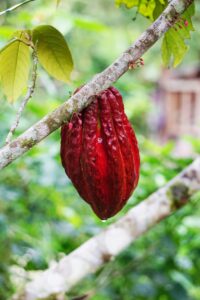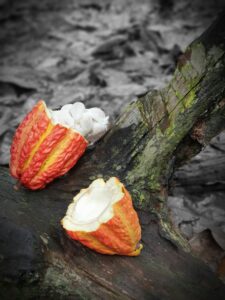FREE SHIPPING for orders of $150 or more! Use coupon code "FREE" Shop now

A Deep Dive into the Process for Making Chocolate
Chocolate, the delectable treat that brings joy to millions, is a result of a fascinating process that transforms cocoa beans into the rich, smooth confection we all love.
Have you ever wondered what goes on behind the scenes to create your favorite chocolate bar?
Join us as we take a deep dive into the intricate process for making chocolate.
How is Chocolate Made Step by Step
From the lush cocoa plantations to the final tempered bars, we’ll uncover the secrets that make chocolate such a beloved and versatile snack.
Cleaning the Cocoa Beans
The first step in making chocolate is cleaning the cocoa beans. This process is important for removing dirt and the dried cocoa pulp. It also tosses out the bad ones that don’t meet standard requirements.
This step is often done by hand, with skilled workers meticulously inspecting each bean to ensure it meets the highest standards.
This attention to detail at the very beginning helps to ensure a truly exceptional chocolate product.

Roasting the Cocoa Beans
Now that the cocoa beans have been cleaned and sorted, it’s time to bring out their unique flavors through the roasting process.
Roasting can be a bit of an art, as it depends on the end result desired.
For a lighter roast, the beans might be roasted for around 30 minutes at 250°F. While for a darker roast, the beans could be roasted for up to 2 hours at the same temperature. The key is to find the perfect balance between the beans’ natural flavors and the desired level of roast.
Proper roasting is essential for a good flavor, as it helps to kill off any bacteria that might be present, reduces the moisture content, and loosens the outer shell of the bean.
Removing the Shell
After the cocoa beans have been carefully roasted, it’s time to remove the outer shell and reveal the treasure inside – the cocoa nibs.
To remove the shell, the roasted beans are cracked open using a winnowing machine or by hand. This process separates the nibs from the shell, and the nibs are then collected and ready for the next step.
To maintain a consistent quality and bring out the best flavors in each variety, the cocoa nibs are combined with 8-10 different varieties of nibs. It’s like a secret chocolate blend that only the experts know about!
This blending process is important because different varieties of cocoa beans have different flavor profiles. Some might be fruity, others might be nutty or earthy. By combining multiple varieties, the chocolatiers can create a harmonious flavor that is greater than the sum of its parts.

Grinding the Nibs
The nibs, which contain 53% cocoa butter, are ground between plates and put into a hydraulic press to get a chocolate paste that looks similar to ordinary butter. This paste is also known as cocoa liquor or cocoa mass.
It is in this phase that the delightful aroma, flavor, and texture of chocolate truly start to form.
Separating the Cocoa Solids from the Cocoa Butter
Now that the cocoa nibs have been blended to create the perfect flavor profile, it’s time to separate the cocoa solids from the cocoa butter through a process called winnowing. This step allows the chocolatiers to control the texture and mouthfeel of the final product.
The separation is done by pressing the cocoa liquor to extract the cocoa butter, leaving behind the cocoa solids. This way, the chocolate makers can control the ratio of each in the final product. This allows them to create a wide range of chocolate products, from dark to milk to white chocolate.

Adding Other Ingredients
Another step is to add other ingredients to create the perfect chocolate bar. This is where the chocolatiers get to flex their creative muscles and put their own unique spin on the recipe.
Depending on the desired end result, the chocolatiers will follow a specific recipe and add the necessary ingredients. This could include things like sugar, milk powder, vanilla extract, or even spices like cinnamon or chili powder.
Of course, the exact recipe is a closely guarded secret, and each chocolatier has their own special blend of ingredients that sets their chocolate apart from the rest. But that’s part of the fun of being a chocolate lover – trying out different brands and varieties to find your personal favorite.
Chocolate Paste Kneaded by Conching Machine
After the entire ingredients have been mixed together, it’s time to let the magic happen. This step is where flavor develops as the ingredients are combined and spread evenly.
The conching process can take anywhere from 4 hours to several days, depending on the desired level of refinement and the type of chocolate being made.
During conching, the chocolate is heated and stirred constantly to develop a smooth and velvety texture by reducing the particle size of cocoa solids and sugar. It also enhances the flavor profile by allowing volatile flavors to evaporate, which can eliminate any harsh or unwanted flavors.
Chocolate is Tempered & Molded (Heating, Cooling and Reheating)
Now it’s time to temper and mold the chocolate. This is where all the hard work and patience pay off, and the chocolate transforms into a delicious, smooth, and snappy treat.
Tempering is a crucial step in chocolate making, and it involves heating, cooling, and reheating the chocolate to achieve the perfect crystal structure. Cooling is important as it thickens the chocolate. It also keeps the flavor from being compromised and prevents separation. Proper tempering also causes the bar to have that “snap” when broken.

Liquid Chocolate is Stored Temporarily
We’ve reached the end of the chocolate-making journey, but the process isn’t quite over yet. In this step, we need to store the liquid chocolate temporarily in a mold.
Since the molding machines can only handle small amounts of chocolate at a time, the leftovers are stored in solid 100-pound blocks or sent to other manufacturers to continue processing. This ensures that the chocolate doesn’t go to waste and can be used to make a variety of products, from bars to truffles.
The storage process is vital because it helps maintain the quality and consistency of the chocolate. The blocks are carefully monitored to ensure they don’t degrade or develop off-flavors, which could affect the final product.
FAQs About Making Chocolate
Can you make chocolate at home?
Yes, you can make chocolate at home. You simply have to follow the process of cleaning, roasting, grinding, tempering and molding the chocolate.
How is chocolate processed?
The process includes harvesting, fermentation, drying, roasting, winnowing, conching, tempering and molding.
Is making chocolate hard?
Making chocolate can be a bit challenging, especially if you are new to the process. However, with the right tools and a little practice, it can be a fun and rewarding experience.
Are you looking for a unique and thoughtful gift for your loved ones? Look no further than MalibuGift’s customized gift boxes!
With our wide range of luxurious under $100 gourmet treats, you can curate the perfect gift box for any occasion.


